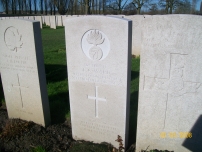| First Name: | Thomas Cornelius | Last Name: | WARD | |
|---|---|---|---|---|
| Date of Death: | 21/03/1918 | Lived/Born In: | Islington | |
| Rank: | Corporal | Unit: | Royal Garrison Artillery 95 Siege Battery | |
| Memorial Site: | ||||
Current Information:Age-28 Enlisted-London Grevillers British Cemetery, France
With an end to the fighting on the Eastern Front after the Russian Revolution, Germany was able to bring its troops from there to France and launch a series of offensives in the Spring of 1918, designed to bring the war to a swift conclusion. Four times between March and July they attacked in strength and on each occasion they broke through the British and French lines and made spectacular gains but in each case they over extended themselves and without adequate supplies keeping up with their rapid advances, they could go no further. The first of these attacks, Operation Michael, was made on 21st March by 63 specially trained divisions, attacking along a 60 mile front held by 26 British divisions, many of them in a weakened state At 4.40am the German artillery opened up with the most ferocious and concentrated bombardment of the war, the likes of which the British had never experienced before. The Forward Zone, consisting mainly of individual posts was blown away. Very few of the men there made it back. Many were killed and many more were taken prisoner. The Battle Zone was also battered as were the British guns, firing from positions just to the rear. Brigade and Divisional HQs were targeted as well and then, from out of the thick mist came the German storm troopers. Moving fast, they skirted round the few remaining strongholds and penetrated deep into the British lines, including those of the Battle Zone, causing the utmost confusion. There were many cases of heroic stands being made but the relentless pressure forced the British back everywhere and there then began a general retreat that went on for two weeks and which ceded to the Germans a huge amount of territory, including all of that that had been won at such great cost during the Battle of the Somme in 1916. The artillery of the British Army suffered heavily on 21st March. At 4.40am the German guns began a five hour bombardment of all British positions including all known artillery emplacements, stretching right back to the rear of the Battle Zone. It was a tremendous and devastating barrage the likes of which had never been seen before and many batteries were put out of action before they had chance to reply. When the enemy storm troopers began their rapid advance the thick fog blanketed their progress and a number of British guns found themselves surrounded before they had a chance to withdraw. Some did manage to get away and a number were able to put up a determined resistance before withdrawing, but overall it was a calamity with hundreds of guns captured or destroyed. For the next ten days all branches of the artillery fell back on a daily basis, stopping every now and then to fire a few rounds in support of the infantry, but desperately trying not to fall into enemy hands. Among the units caught up in the events of 21st March was the 95th Siege Battery of the Royal Garrison Artillery, in action on Fifth Army front, and among their casualties was Thomas Ward who was killed in action. |
||||
| « Back to Search Results | ||||
| If you think any of the information shown here is incorrect, Click Here to submit your amends and comments | ||||




